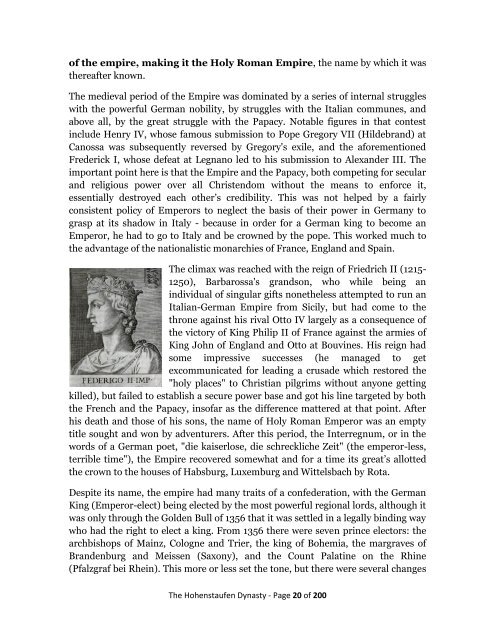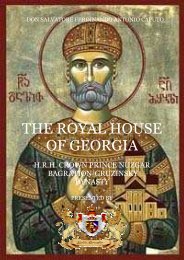here - Nobility Associations
here - Nobility Associations
here - Nobility Associations
You also want an ePaper? Increase the reach of your titles
YUMPU automatically turns print PDFs into web optimized ePapers that Google loves.
of the empire, making it the Holy Roman Empire, the name by which it was<br />
t<strong>here</strong>after known.<br />
The medieval period of the Empire was dominated by a series of internal struggles<br />
with the powerful German nobility, by struggles with the Italian communes, and<br />
above all, by the great struggle with the Papacy. Notable figures in that contest<br />
include Henry IV, whose famous submission to Pope Gregory VII (Hildebrand) at<br />
Canossa was subsequently reversed by Gregory's exile, and the aforementioned<br />
Frederick I, whose defeat at Legnano led to his submission to Alexander III. The<br />
important point <strong>here</strong> is that the Empire and the Papacy, both competing for secular<br />
and religious power over all Christendom without the means to enforce it,<br />
essentially destroyed each other’s credibility. This was not helped by a fairly<br />
consistent policy of Emperors to neglect the basis of their power in Germany to<br />
grasp at its shadow in Italy - because in order for a German king to become an<br />
Emperor, he had to go to Italy and be crowned by the pope. This worked much to<br />
the advantage of the nationalistic monarchies of France, England and Spain.<br />
The climax was reached with the reign of Friedrich II (1215-<br />
1250), Barbarossa's grandson, who while being an<br />
individual of singular gifts nonetheless attempted to run an<br />
Italian-German Empire from Sicily, but had come to the<br />
throne against his rival Otto IV largely as a consequence of<br />
the victory of King Philip II of France against the armies of<br />
King John of England and Otto at Bouvines. His reign had<br />
some impressive successes (he managed to get<br />
excommunicated for leading a crusade which restored the<br />
"holy places" to Christian pilgrims without anyone getting<br />
killed), but failed to establish a secure power base and got his line targeted by both<br />
the French and the Papacy, insofar as the difference mattered at that point. After<br />
his death and those of his sons, the name of Holy Roman Emperor was an empty<br />
title sought and won by adventurers. After this period, the Interregnum, or in the<br />
words of a German poet, "die kaiserlose, die schreckliche Zeit" (the emperor-less,<br />
terrible time"), the Empire recovered somewhat and for a time its great’s allotted<br />
the crown to the houses of Habsburg, Luxemburg and Wittelsbach by Rota.<br />
Despite its name, the empire had many traits of a confederation, with the German<br />
King (Emperor-elect) being elected by the most powerful regional lords, although it<br />
was only through the Golden Bull of 1356 that it was settled in a legally binding way<br />
who had the right to elect a king. From 1356 t<strong>here</strong> were seven prince electors: the<br />
archbishops of Mainz, Cologne and Trier, the king of Bohemia, the margraves of<br />
Brandenburg and Meissen (Saxony), and the Count Palatine on the Rhine<br />
(Pfalzgraf bei Rhein). This more or less set the tone, but t<strong>here</strong> were several changes<br />
The Hohenstaufen Dynasty - Page 20 of 200



